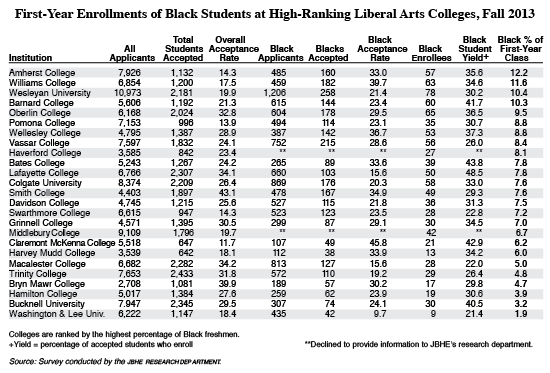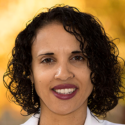![]() For 20 years JBHE has collected black student admissions data on the highest-ranked liberal arts colleges. Over this long period, there have been seven years when Amherst College reported the highest percentage of black freshmen. In fact, Amherst has led the rankings for the five of the past six years. On six occasions, Wesleyan University in Middletown, Connecticut, had enrolled the highest percentage of Black first-year students. Williams College has also been a consistent performer in attracting a large group of Black first-year students and has consistently been at or near the top of the rankings.
For 20 years JBHE has collected black student admissions data on the highest-ranked liberal arts colleges. Over this long period, there have been seven years when Amherst College reported the highest percentage of black freshmen. In fact, Amherst has led the rankings for the five of the past six years. On six occasions, Wesleyan University in Middletown, Connecticut, had enrolled the highest percentage of Black first-year students. Williams College has also been a consistent performer in attracting a large group of Black first-year students and has consistently been at or near the top of the rankings.

This year, Amherst College has retaken the top spot in our survey. There are 57 Black first-year students at Amherst this year. They make up 12.2 percent of the entering class. Last year, Amherst dropped to fourth place in our survey with an entering class that was 10.3 percent Black.
As stated, Williams College has been a consistent performer and this year is no exception. There are 63 Black first-year students at Williams this year. Williams ranks second in our survey with a freshman class that is 11.6 percent Black, up from 10.8 percent a year ago.
Wesleyan University, which as stated, has led our ranking on six occasions including last year, ranks third in this year’s survey. There are 78 Black freshmen at the college this year and they make up 10.4 percent of the entering class at Wesleyan. Last year, when Wesleyan led the ranking, Blacks were 11.3 percent of the entering class.
Barnard College in New York City is the only other highly ranked liberal arts college in our survey where Black students are more than 10 percent of the entering class. There are 60 Black women in the Barnard entering class, making up 10.3 percent of the first-year students. Last year, Barnard was in 11th place in our survey with an entering class that was 7.3 percent Black.
Oberlin College in Ohio, a liberal arts institution with a long history of providing educational opportunities for African Americans, ranks in fifth place this year with an entering class that is 9.5 percent Black. Oberlin was in seventh place a year ago.
In sixth place this year is Pomona College, up from 14th a year ago. The percentage of Blacks in the entering class at Pomona increased from 6.9 percent to 8.8 percent.
Wellesley College, Haverford College, and Vassar College are the only other liberal arts colleges in our survey where Blacks are 8 percent or more of the entering class.
A Note on Methodology
Before we continue with the results, it is important to mention how the U.S. Department of Education collects data on the race of undergraduates. Before the change was made several years ago, students who reported more than one race (including African American) were included in the figures for Black students. This is no longer the case. Thus, students who self-identify as biracial or multiracial with some level of African heritage are no longer classified as Black by the Department of Education.
JBHE surveys have always asked respondents to include all students who self-identify as having African heritage including those who are actually from Africa. JBHE has always maintained that biracial, multiracial, and Black students from Africa add to the diversity of a college campus. And including these students in our figures offers college-bound Black students a better idea of what they can expect at a given college or university. In order that we can compare our current data to past JBHE surveys we have continued to asked colleges and universities to include all students who identify themselves as having African heritage.
Some colleges who have not responded to our survey are insistent on reporting only data that is compatible with the Department of Education reporting requirements. They are reluctant to report data to JBHE because their numbers of Black students will be lower than colleges and universities that include biracial and multiracial students with African heritage in their figures.
Liberal Arts Colleges: Short-Term Gainers

Now we turn to a comparison of this year’s results with the data from last year. For the 24 colleges for which we have data in both 2012 and 2013, 14 colleges posted gains over last year in black enrollments. Nine colleges showed a decline and Davidson College in North Carolina had exactly the same number of Black freshmen as was the case a year ago.
Harvey Mudd College in Claremont, California, showed a huge 333 percent increase in Black freshmen from 2012. There were three Black first-year students in 2012 and 13 this year. The percentage of Blacks in the entering class jumped from 1.5 percent to 6 percent.
Bates College is Maine also showed a major increase from 12 Blacks in the entering class in 2012 to 39 this year, a rise of 225 percent. The percentage of Black students in the entering class increased from 2.8 percent in 2012 to 7.8 percent this year.
Other liberal arts college with significant percentage increases in Black first-year students are Claremont McKenna College in Claremont, California, Grinnell College in Iowa, and Barnard College in New York City.
Liberal arts colleges that showed significant declines in Black first-year students were Bryn Mawr College in Pennsylvania and Washington and Lee University in Lexington, Virginia.
Black Acceptance Rates at Liberal Arts Colleges
Acceptance rate data is a closely guarded secret at many high-ranking universities. But most of the nation’s leading liberal arts colleges are willing to disclose this information.
Last year, for the first time in the history of the JBHE survey of liberal arts colleges, more responding colleges had a lower acceptance rate for Black students than their overall acceptance rate than the number of colleges that had a Black acceptance rate that was higher than their overall rate. This is true once again this year
At 11 of the 23 high-ranking liberal arts colleges for which we have data, the Black acceptance rate was higher than the acceptance rate for all applicants. In some cases the differences were very large. For example, at Amherst College 33 percent of Black applicants were admitted compared to 14.3 percent of all applicants to the college. At Williams, the Black acceptance rate of 39.7 percent is more than double the rate for all Williams students, which stood at 17.5 percent.
At 12 of the 23 high-ranking liberals arts colleges for which we have data, the Black acceptance rate was lower than the rate for all students. At some, the differences were substantial. At Lafayette College in Easton, Pennsylvania, 34.1 percent of all applicants were admitted. But only 15.6 percent of Black applicants received notices of acceptance. At Macalester College in Minnesota, 34.2 percent of all students were accepted but only 15.6 percent of Black students were admitted.
While no conclusions can be made from one or two year’s figures, the fact that there are now more colleges with overall acceptance rates that are higher than Black acceptance rates, causes one to wonder if there has been some curtailment in colleges’ consideration of race in admissions decisions.
For the past two years, the highest black student yield among the leading liberal arts colleges in our survey belonged to Barnard College. This year Lafayette College has the highest Black student yield at 48.5 percent. The only other high-ranking liberal arts colleges with a black student yield of more than 40 percent are Barnard College, Bates College, Bucknell University, and Claremont McKenna College.











